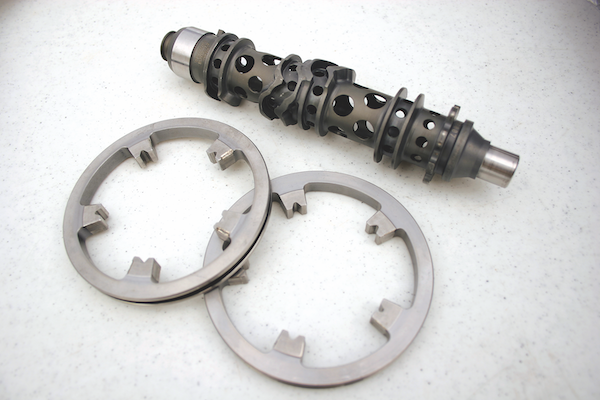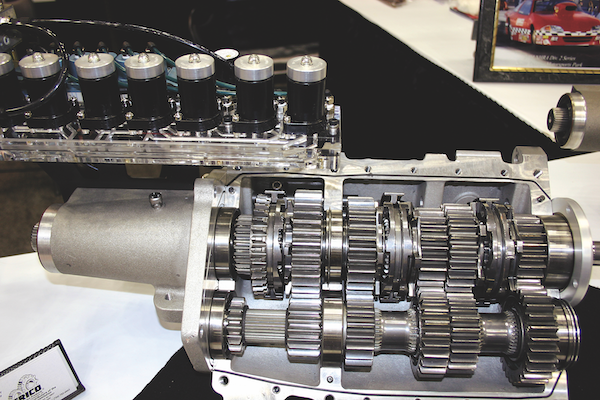Automatic transmissions obviously shift for you, and as a result, there are no missed shifts with an automatic. If you use an automatic transmission coupled to a torque converter, you will in most cases see more horsepower loss at the rear wheels compared to a manual transmission. There are, however, many factors that determine winning a race other than rear-wheel horsepower loss. Missing a shift in a drag race will cost you the race no matter how efficient your gearbox is. Unless you can step up to a dependable and consistent manual transmission for drag racing, sometimes it is cheaper and more cost-effective to go with an automatic.
HOW TO REBUILD & MODIFY HIGH-PERFORMANCE MANUAL TRANSMISSIONS
For a comprehensive guide on this entire subject you can visit this link:
LEARN MORE ABOUT THIS BOOK HERE
SHARE THIS ARTICLE: Please feel free to share this article on Facebook, in Forums, or with any Clubs you participate in. You can copy and paste this link to share: http://www.cartechbooks.com/techtips/manual-transmission-performance-upgrades/
Road racing is another story. There are many gear ratios needed to negotiate various race tracks. Daytona may require a different set of ratios compared to Sebring. In a road-race environment, automatic design does not allow for quick ratio changes, quick tear-down, or the availability of efficient 4-, 5-, 6-, or even 7-speeds. Endurance events, such as NASCAR-style racing, require designs to be as light and efficient as possible. With the newer style of metal alloys available today combined with the state-of-the-art CNC machining and 3D modeling, gear design has evolved to a level that allows for stronger horsepower capacity within a smaller configuration.
In a typical synchronized 4-speed, such as a Muncie, T10, Chrysler, or Ford Toploader, the transmission has 36 engagement or clutch teeth on the gear. The matching slider that engages the gear has the same number of teeth. When spinning above 6,000 rpm, the surface speed of the gear and slider can be very different in certain ratios.
I always associate this with trying to place a stick through a picket fence while driving by that fence at 60 mph. If I’m standing still, I can stick it between the pickets, but if I’m driving by at 60 mph, the stick may bounce off the fence. However, if I remove every 10 pickets from the fence I can get the stick through the fence at 60 mph just as easily as if I were standing still.
So, getting back to those 36 engagement teeth, if I remove every other tooth on the gear and slider, I’ve effectively cut my surface speed in half. At 6,000 rpm I now have the surface speed of a 3,000-rpm shift. The downside is that the engagement teeth must carry double the load they were originally designed for. This technique is called “slick shifting.” From the 1960s to the early 1980s, it was possible to find new sliders specifically made for slick shifting. You purchased the sliders and modified your own gears. In fact, you could purchase from Chrysler complete, new gearsets and sliders for the A833.

The standard A833 slider ring featured 36 teeth, but Chrysler was the only one of the Big Three to offer an 18-tooth slick-shift slider ring. Every other tooth has been machined away to create the 18-tooth gear.

Stock Muncie input on the left, and one modified with Liberty’s Pro Shift Ring on the right.

A JT5 Enduro gear has this removable dog ring faceplate. Notice how large the window is between the lugs. The larger window allows for higher RPM shifts.

The latest version of a dual-countergear transmission increases load capacity by putting more gear teeth in contact with one another and splitting the load in half.

A complete proshifted Muncie 4-speed utilizing new gears.

Because you are using two countergears, they must be timed. I’m pointing to the timing mark. The opposite gear has to be on the exact same tooth, or the transmission will lock up.

Bar stock cut for an input shaft made out of 9310VAR alloy.
This Tech Tip is from the full book,
HOW TO REBUILD & MODIFY HIGH-PERFORMANCE MANUAL TRANSMISSIONS
For a comprehensive guide on this entire subject you can visit this link:
LEARN MORE ABOUT THIS BOOK HERE
SHARE THIS ARTICLE: Please feel free to share this post on Facebook Groups or Forums/Blogs you read. You can use the social sharing buttons to the left, or copy and paste the website link: https://www.cartechbooks.com/blogs/techtips/manual-transmission-performance-upgrades

A G-Force racing countergear is being machined for a T5.

A Muncie 4-speed countergear that had broken first gear is recycled. The broken teeth are ground away to make a 3-speed dirt track transmission.

This shows the intricate machining of a Formula 1 titanium shift barrel and dog rings.
In the mid 1960s a tool-and-diemaker for Cadillac was trying to improve on the slick-shifting concept. His design revolutionized the way transmissions shifted, and his name became synonymous with drag-race transmissions. Joe Liberty slick shifted his friend’s transmissions for drag racing. Reducing the number of clutch teeth from 36 to 18 may have increased shift speed, but it promoted more wear. So he invented the “pro-shift” ring. The ring decreased the number of clutch teeth to 12 but increased the width, giving them back their holding power.
By 1972, business was so good that Joe left Cadillac Motors and started Liberty’s High Performance Products. Liberty patented the concept of the pro-shift ring as a modification to a factory gear by grinding off the old engagement teeth and welding a new pro-shift ring. Next modified a Chrysler A833 with clutchless gears and won bestengineered product at the 1974 SEMA Show. These transmissions were made with completely new gears, which was also a first because few people back then had the resources to do such a thing. However, the transmission was not allowed in its intended racing class because the rulemakers thought it would give Chrysler an unfair advantage.
The modified A833 was only allowed in a class that it really wasn’t designed for. This led to gear breakage. One day Joe was sitting at his desk rolling around some gears and watched three gears roll against one another. He came up with a new idea, paving the way for the first dual-cluster gear transmission. By putting the mainshaft between two countergears, mainshaft deflection is avoided and the load of the transmission is split between the two gears. This design increased the strength by 2.8 times.
The significance of Joe Liberty’s concepts and designs sometimes went unnoticed. He was also the first to “combo” gears. Grinding off the countergear’s headgear is the first step of the process. To create a different ratio he cut the head gear off from another countergear and combined the two by welding them together. I sold many gears made like this and can vouch that the welds never broke. When I asked Joe how he found someone to weld gears, he replied, “In Detroit there was an abundance of talent. You could find anyone to make anything. That’s just how things were done.”
Today, because of advanced alloys combined with CNC machinery, a multitude of performance transmissions are made with some unique designs. Because most of these transmissions are not massproduced every gear starts as a piece of bar stock.
Racing transmissions can be shifted in a standard H-style pattern or a “sequential” pattern. A sequential pattern means you pull the stick in one direction for upshifts and in another direction for downshifts. There is no side-to-side movement; thus you don’t have to worry about missing shifts because there are no gates. The concept basically is the same as a motorcycle transmission. A shift barrel rotates, and the rotation is translated into a linear movement of the shift fork.

A transmission by Quaife uses a sequential barrel with dog-ring gears.

The Lenco transmission shifts by applying bands to lock the planetary gears in place. It’s like manually shifting the bands of an automatic transmission.
This Tech Tip is from the full book,
HOW TO REBUILD & MODIFY HIGH-PERFORMANCE MANUAL TRANSMISSIONS
For a comprehensive guide on this entire subject you can visit this link:
LEARN MORE ABOUT THIS BOOK HERE
SHARE THIS ARTICLE: Please feel free to share this post on Facebook Groups or Forums/Blogs you read. You can use the social sharing buttons to the left, or copy and paste the website link: https://www.cartechbooks.com/blogs/techtips/manual-transmission-performance-upgrades

The engagement teeth of a clutchless drag race transmission. Note how the dog teeth are ramped to pull themselves into gear.

In this Jerico air-shifted racing 5-speed, air is shuttled from one solenoid to another.

A JT5 Enduro 5-speed gear set is retrofitted into a stock T5 case.

This Roltek T10 4-Speed is used for road racing with a Long Shifter.

This is a G-Force GF-2000 5-speed transmission. Notice the dual forks and slider for the clutchless operation. As one slider engages, the other is pulled from the opposite side.

This Hightower Racing transmission can actuate shift rods that are completely vertical, which makes this shifter unique and keeps the rods closer to the transmission’s extension housing.

The G-Force GT-50 clutchless front-wheel-drive drag race transmission uses “Remmed” gears and a special Teflon dry-film coating on the case to promote oil flow.

The Muncie first gear on the right has been shot peened, deburred, and Mikronited.

The 5speeds.com Muncie SPEC25 uses the same coating as the G-Force GT-50. It’s a fully synchronized transmission for race classes that require a synchronized transmission. The gears are also processed in the same fashion.

Keisler Engineering modified the Tremec TKO 600 to incorporate a side-mount shifter so it could be used in older muscle car applications.
Besides making transmissions with bigger components and stronger alloys, you can also use some of the techniques the big boys use on your everyday 4-speed. Deburrr all gears to get rid of high spots that can cause the slightest gear misalignment. Rarely do you find new gears that are not dinged. In the past, people have shot peened gears to add strength. Newer processes, such as Mikronite and Rem, chemically polish and peen gears. There are dry-film lubricant coatings available and the cryogenic treatment of gears, which can increase gear strength like a normal heat treatment would.
Very small companies have completely reproduced the Muncie, Toploader, and A833 4-speed. The costs to accomplish this would have been prohibitive 10 years ago. The quality and accuracy of the machine work far exceeds what was done 40 years ago. I expect this trend to continue as global markets open up and as unique and important designs materialize faster.
Written by Paul Cangialosi and Posted with Permission of CarTechBooks




